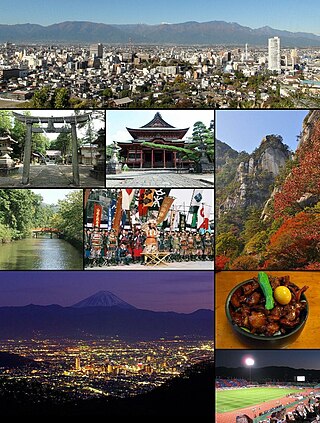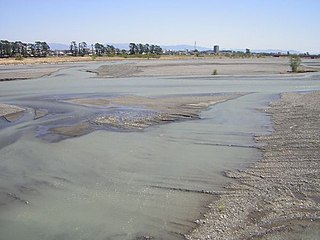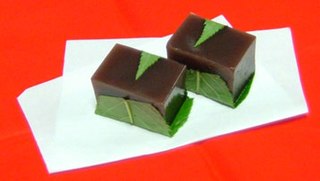
Mochi is a Japanese rice cake made of mochigome (もち米), a short-grain japonica glutinous rice, and sometimes other ingredients such as water, sugar, and cornstarch. The steamed rice is pounded into paste and molded into the desired shape. In Japan, it is traditionally made in a ceremony called mochitsuki. While eaten year-round, mochi is a traditional food for the Japanese New Year, and is commonly sold and eaten during that time.

Kakigōri (かき氷) is a Japanese shaved ice dessert flavored with syrup and a sweetener, often condensed milk.

Takeda Shingen was daimyo of Kai Province during the Sengoku period of Japan. Known as the "Tiger of Kai", he was one of the most powerful daimyo of the late Sengoku period, and credited with exceptional military prestige. Shingen was based in a poor area with little arable land and no access to the sea, but he became one of Japan's leading daimyo. His skills are highly esteemed and on par with Mōri Motonari.

Kōfu is the capital city of Yamanashi Prefecture, Japan. As of 1 April 2019, the city had an estimated population of 187,985 in 90,924 households, and a population density of 880 persons per km2. The total area of the city is 212.41 square kilometres (82.01 sq mi).

The Abe River is a Class A river in Shizuoka Prefecture of central Japan. It is 53.3 kilometres (33.1 mi) long and has a watershed of 567 square kilometres (219 sq mi). Approximately 170,000 people live in the basin area.

Wagashi is a traditional Japanese confection made of mochi, anko, and fruit. Wagashi is typically made from plant-based ingredients with an emphasis on seasonality, and generally making use of cooking methods that pre-date Western influence in Japan. It is often served with green tea.

Yōkan is a wagashi made of red bean paste, agar, and sugar. It is usually sold in a block form, and eaten in slices. There are two main types: neri yōkan and mizu yōkan. Mizu means "water", and indicates that it is made with more water than usual. Mizu yōkan is usually chilled and eaten in the summer, however in Fukui prefecture it is customarily eaten in winter.

Yakimochi is grilled or broiled mochi or pounded rice cake. Traditionally, it is prepared using a small charcoal grill, but in modern times a gas grill can be used. During the time of the Autumn Moon, it is traditional to eat fresh yakimochi while sipping sake and enjoying the view of the full moon.

Kusa mochi, also known as yomogi mochi (蓬餅), is a Japanese confection. It is made from mochi and leaves of yomogi. The leaves are kneaded into the mochi, giving it a vivid green color. The greenness depends on the amount of Japanese mugwort blended in the mochi.

Tangyuan are a traditional Chinese dessert made of glutinous rice shaped into balls that are served in a hot broth or syrup. They come in varying sizes, anything between a marble to a ping pong ball, and are sometimes stuffed with filling. Tangyuan are traditionally eaten during the Lantern Festival, but because the name is a homophone for union and symbolizes togetherness and completeness, this dish is also served at weddings, family reunions, Chinese New Year, and the Dōngzhì festival.

Manjū is a traditional Japanese confection, usually a small, dense bun with a sweet filling. They come in many shapes and varieties.

Imagawayaki (今川焼き) is a wagashi often found at Japanese festivals as well as outside Japan, in countries such as Taiwan and South Korea. It is made of batter in a special pan, and filled with sweet azuki bean paste, although it is becoming increasingly popular to use a wider variety of fillings such as vanilla custard, different fruit custards and preserves, curry, different meat and vegetable fillings, potato and mayonnaise. Imagawayaki are similar to dorayaki, but the latter are two separate pancakes sandwiched around the filling after cooking, and are often served cold.

A Mont Blanc is a dessert of sweetened chestnut purée in the form of vermicelli, topped with whipped cream. It was created in nineteenth-century Paris. The name comes from Mont Blanc, as the dish resembles a snow-capped mountain.

Kuzumochi (葛餅/久寿餅) is a Japanese term referring either to mochi cakes made of kuzuko (葛粉), starch derived from the root of the kudzu plant, or mochi cakes made from Lactobacillales-fermented wheat starch (久寿餅) which is speciality dish local to certain wards of Tokyo, served chilled and topped with kuromitsu and kinako.
A Kibi dango is a type of wagashi sweet or snack with an eponymous reference to Kibi-no-kuni, an old province roughly coincident with today's Okayama Prefecture. It is made by forming gyūhi, a sort of soft mochi, into flat round cakes. Glutinous rice, starch, syrup and sugar are the basic ingredients. It is manufactured by some fifteen confectioners based in Okayama City. While perhaps originally made from kibi, the modern recipe uses little or no millet, and substantively differs from kibi dango of yore, famous from the Japanese heroic folk tale of Momotarō or "Peach Boy"; nevertheless, "Kibi dango" continues to be represented as being the same as the folk hero Peach Boy's dumpling.
Kibi dango is Japanese dumpling made from the meal or flour of the kibi grain. The treat was used by folktale-hero Momotarō to recruit his three beastly retainers, in the commonly known version of the tale.

Zunda-mochi (ずんだ餅) is a type of Japanese confectionery popular in northeastern Japan. It is sometimes translated as "green soybean rice cake." It generally consists of a round cake of short-grained glutinous rice with sweetened mashed soybean paste on top. In some varieties, the green soybean paste entirely covers the white rice cake. In all cases, immature soybeans known as edamame are used. A closely related product is "kurumi-mochi", which uses walnuts instead of soybeans.
Matsuhime or Shinsho-ni (信松尼) was a Japanese noblewoman who was a member of the Takeda clan, an important samurai family of the Sengoku period. She was the daughter of Takeda Shingen and wife of Oda Nobutada. She is best known for trying to strengthen an ailing alliance between Takeda and Oda, two rival families. Matsu is also known for her rightful love and undying devotion to Oda Nobutada, which is considered unusual for the time period. A mountain pass is named Matsuhime Tōge in her honor due to her having used the path to escape Oda Nobunaga's army. The Shinsho-in temple in Hachioji (Tokyo) preserves to this day a wooden statue of Matsuhime and the naginata (polearm) she wielded.

Gold Kingdom and Water Kingdom is a Japanese manga series written and illustrated by Nao Iwamoto. It was serialized in Shogakukan's Flowers magazine from October 2014 to April 2016, with its chapters collected into a single tankōbon volume. It tells the story of Princess Saara and Prince Naranbayar, who, in a bid to maintain peace between their rival kingdoms, enter into a pretend marriage and unexpectedly begin to fall in love.


















